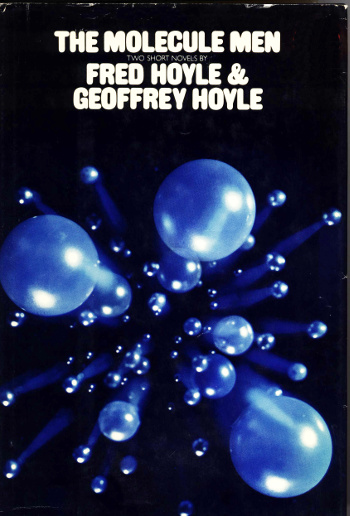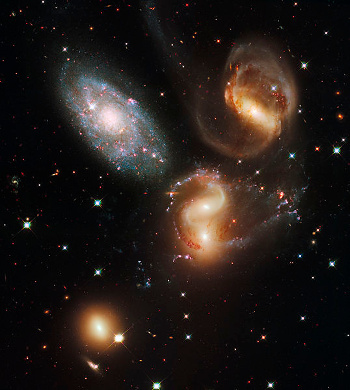Clinging to Theory
August 18, 2016
People cling to tried-and-true ways, and that's likely the reason why our
species has survived. Pity the first man who was tempted to try a novel
food, only to
sicken and
die as a warning to others.
Man may not live by bread alone, but
bread is a rather
safe foodstuff, aside from the occasional
aflatoxin. The
human nature to resist change has caused problems when
scientists cling to old
theories, even in the face of mounting
evidence that discredits them.
One modern example of this from
cosmology is the
steady-state theory of the universe, championed primarily by
astronomer,
Fred Hoyle, and his
colleagues,
Thomas Gold and
Hermann Bondi.[1] It was Hoyle who coined the term "
Big Bang," for the competing theory. He used the term
pejoratively in 1949; but, somehow, the term was embraced by the opposition, since it was quite descriptive.

Dust jacket of the 1971
book, The Molecule Men, containing two short
novels by Fred Hoyle and
Geoffrey Hoyle.
Fred Hoyle was a prolific
author of
science fiction. Some of his works were co-authored with his
son, Geoffrey Hoyle.
My favorite among Hoyle's works that I've read is his 1966 novel,
October the First Is Too Late(Scan of my copy.)
As time went on, and evidence for the Big Bang accumulated, Hoyle and his colleagues devised various arguments for why
data could be consistent with their steady state theory. One of their ideas was that
matter was
continually created as the universe expanded. The necessary creation is quite small, being just one
hydrogen atom per
cubic meter per
billion years, which is quite undetectable. Hoyle became more
isolated from the community of astronomers as he tried, over the years, to buttress his failing theory.
Another example of clinging to theory despite mounting evidence involves
Stephan's Quintet, as shown in the image. The upper left
galaxy,
NGC 7320, has a
redshift of just 790
kilometers-per-second (km/s), while the other four galaxies have the large redshift of about 6600 km/s. According to
Hubble's law, NGC 7320 is very much closer to
Earth than the others.

Hubble Space Telescope image of Stephan's Quintet.
Although the five galaxies appear to be in the same group, the upper left galaxy, NGC 7320, is in the foreground, and it's much closer to the Earth than the others.
(NASA, ESA, and Hubble SM4 ERO Team image, via Wikimedia Commons.)
In the 1960s, astronomer,
Halton Arp, noticed what appeared to be a
tidal tail linking NGC 7320 to its "neighbor" galaxy in the quintet. This observation, coupled with a
statistic that large redshift
quasars apparently associated with low redshift
active galaxies, led Arp to believe that not all redshifts were "cosmological;" that is, not all were a consequence of Hubble's law.[2] Arp, a talented
observational astronomer, published a 1966 book, the
Atlas of Peculiar Galaxies, which demonstrated that there was much still lacking in our understanding of galaxies at that time.
There was no apparent
mechanism to explain the supposed non-cosmological redshifts in quasars. Arp was another who thought all could be explained by Hoyle's steady-state model as further developed by
Indian cosmologist,
Jayant Narlikar. Arp championed alternatives to the Big Bang throughout his life, even in light of pressing evidence in favor of that model.
While these are extreme examples, a scientist's desire to cling to old theories has always existed in science. As
Thomas Kuhn's, explained in his 1962 book, "The Structure of Scientific Revolutions,"[3] scientists work within a paradigm, which is the collection of the shared theories in their particular fields. While working within these paradigms, they are practicing "normal" science. I wrote about the fiftieth
anniversary of Kuhn's book in an
earlier article (Fifty Years of Paradigm Shifting, February 25, 2013).
When little inconsistencies start to pile up in such a paradigm, scientists start to feel that things are not quite right. Finally, someone comes along with a new paradigm, and there's a
paradigm shift. Examples of paradigm-shifting are the heliocentric solar system, relativity, and quantum theory.
As these three example illustrate, there's always considerable resistance to a change from the old ways, and some scientists will have trouble adjusting to the new paradigm. A changed paradigm might itself change. Phlogiston theory was supplanted by caloric theory, which was then superseded by the mechanical theory of heat.

Left, German physician and chemist, Johann Joachim Becher (1635-1682), in a circa 1682 engraving. Right, German chemist, Georg Ernst Stahl (1659-1734), in a 1715 engraving. Becher originated the Phlogiston theory, which was further developed by Stahl. Becher was a prolific writer of science, publishing a treatise on metallurgy (Metallurgia, 1660), and he was interested in alchemical subjects, such as the Philosopher's Stone (Tractatus de lapide trismegisto, 1654). (left image and
right image via Wikimedia Commons. Right image is from the Wellcome Trust, image ICV No. 5805])
As these examples from science show, having a commitment to something makes it difficult for us to reject that item, and it's amazing how deeply this principle extends into our daily lives. As part of her doctoral dissertation at
Duke University,
Avni M. Shah led an interesting study of how commitment influences subsequent
behavior.[4-5] The level of commitment can be as seemingly insignificant as paying for something with
cash instead of using a
credit card. Shah is now an
assistant professor at the
University of Toronto Scarborough.
As the study shows, when people pay using a relatively more "painful" forms of payment, such as cash, or
check, their post-transaction connection to the purchased product is greater than that of those who pay with less painfully by
debit card or credit card.[4] People who painfully pay have a greater
emotional attachment to a product, and they are more likely to repeat such a transaction.[4] Interestingly, this effect appears even when the
psychological cost is indirect, as when a person is
donating someone else's money.[4]

The title of the paper by Shah and coauthors is "Paper or Plastic?"
(University of Toronto Scarborough image.)
Two
experiments were done, the first of which had
test participants buy a
coffee mug, normally priced at $6.95, for the
discounted price of $2 with either cash or credit. When they were asked two hours later to sell back their mugs at a price of their choosing, the cash payers asked for nearly $3 more for the mug than those who paid using a card.[5] The second experiment eliminated any
variables that might be attached to cash or credit transactions, such as
ATM fees and
card bonus points, by giving the participants $5 in cash, or as a
voucher, to deposit with one of three
charities in return for a
lapel pin.[5]
Says Shah,
"Debit and credit cards rule the marketplace, and while going cashless is convenient, that convenience may come at a price... We found that people who donated by cash felt more connected to their chosen charity than those who donated by voucher. Cash donors also reported feeling less connected to the charities they didn't chose... In other words, paying by cash made people feel more attached to what they bought and less connected to what they didn't buy."[5]
Such research explains why scientists cling to their old theories longer than they should. They put a lot of effort into their theory-building; and, since hard work is painful, they have a strong emotional attachment to their theory. One interesting study would be whether clinging to theory is less prevalent in this age of easy
electronic publication.
References:
- Mario Livio, "Brilliant Blunders: How the Big Bang Beat Out the Steady State Universe," NOVA blog from PBS, June 27, 2013.
- W. Keith Fisher, "Astronomy - The Red Shift Controversy," W. Keith Fisher's Blog, February 19, 2010.
- Thomas S. Kuhn, "The Structure of Scientific Revolutions: 50th Anniversary Edition," University Of Chicago Press (Fourth Edition edition, April 30, 2012), ISBN-13: 978-0226458120, 264 pages (via Amazon).
- Avni M. Shah, Noah Eisenkraft, James R. Bettman, and Tanya L. Chartrand, "'Paper or Plastic?': How We Pay Influences Post-Transaction Connection," Journal of Consumer Research, vol. 42, no. 5 (February 1, 2016), pp. 688-708, DOI: 10.1093/jcr/ucv056.
- Don Campbell, "Paper or plastic? The way we pay influences how much we value our purchase," University of Toronto Press Release, June 28, 2016.
Permanent Link to this article
Linked Keywords: Species; food; toxicity; sick; death; die; human; Man; proverbial phrase; not live by bread alone; bread; safe; aflatoxin; human nature; scientist; theory; scientific evidence; physical cosmology; steady-state theory of the universe; astronomer; Fred Hoyle; colleague; Thomas Gold; Hermann Bondi; Big Bang; pejorative; dust jacket; book; novel; Geoffrey Hoyle; author; science fiction; son; October the First Is Too Late; data; matter; Perfect Cosmological Principle; continuous creation; hydrogen atom; cubic meter; billion years; social isolation; Stephan's Quintet; galaxy; NGC 7320; redshift; kilometers-per-second; Hubble's law; Earth; Hubble Space Telescope; NASA; European Space Agency; ESA; Halton Arp; tidal force; statistic; quasar; active galactic nucleus; active galaxy; observational astronomy; observational astronomer; Atlas of Peculiar Galaxies; physical mechanism; Indian; Jayant Narlikar; Thomas Kuhn; The Structure of Scientific Revolutions; paradigm; anniversary; paradigm shift; heliocentrism; heliocentric solar system; theory of relativity; quantum theory; phlogiston theory; caloric theory; mechanical theory of heat; German; physician; chemist; Johann Joachim Becher (1635-1682); engraving; Georg Ernst Stahl (1659-1734); science; treatise; metallurgy; alchemy; alchemical; Philosopher's Stone; Wikimedia Commons; Wellcome Trust; thesis; doctoral dissertation; Duke University; Avni M. Shah; behavior; cash; credit card; assistant professor; University of Toronto Scarborough; check; debit card; emotion; emotional; psychology; psychological; donation; experiment; human subject research; test participant; coffee mug; discounted price; independent variable; ATM fee; loyalty program; card bonus points; voucher; charitable organization; charity; lapel pin; marketplace; electronic publication; Thomas S. Kuhn, "The Structure of Scientific Revolutions: 50th Anniversary Edition," University Of Chicago Press (Fourth Edition edition, April 30, 2012), ISBN-13: 978-0226458120, 264 pages.